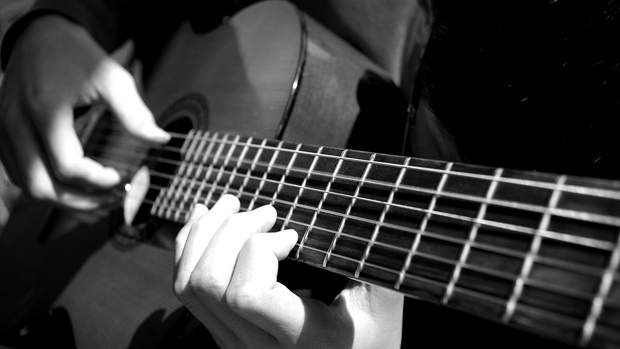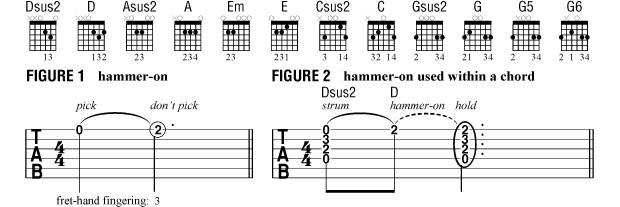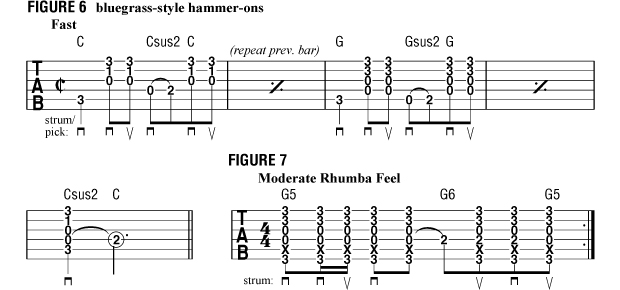Lesson: Hammer-ons and Sus2 Chords

One simple technique that is often used to spice up many chords — and in the process make a lot of garden-variety chord progressions sound more interesting — is the hammer-on.
To play a hammer-on, pick a string and then, while the note is still ringing, sound a higher note on that same string by firmly tapping, or “hammering,” it onto the fretboard with one of your fretting fingers without picking it again.
Figure 1 shows a hammer-on from the open high E string to the F# note at the second fret. Pick the open E string, then hammer on the F# note with your middle finger. The object is to make the hammered note clearly audible and keep the string vibrating, so make sure you tap the string firmly. You needn’t use a lot of force when hammering. The key is to execute the move quickly once the finger is set in motion.

Figure 2 demonstrates how this same E-to-F# hammer-on can be used to decorate a familiar open D chord. Strum the Dsus2 chord as indicated, then, while holding the two fretted notes with your index and ring fingers, hammer on the F# note with your middle finger, just as you did in Figure 1. Repeat this procedure several times, until the hammered F# note rings as clearly as the rest of the notes of the chord.
Figure 3a depicts an open-position D chord played in a standard strum pattern. I’m sure you’ll agree that while this sounds nice, it quickly becomes drone-y and monotonous. Now listen to what happens when we add the Dsus2-D hammer-on illustrated in Figure 2 to this same strum pattern, as demonstrated in Figure 3b. Suddenly, it sounds melodic, like something you’d hear in a real song.

Figure 4 is an example of a sus2 hammer-on applied to an A major chord (Asus2-A). Notice how the melodic effect created by the two hammer-ons is enhanced by their use in conjunction with arpeggiation (picking out the notes of the chord in succession, as opposed to strumming them together.)

Hammer-ons are commonly employed by blues players, both electric and acoustic. One very popular embellishment involves hammering-on from the minor third of a chord to the major third. You’ll certainly recognize the sound of the sequence illustrated in Figure 5, in which an open E minor chord quickly becomes an E major chord when the G# note (first fret, third string) is hammered onto from the open G string that is part of the E minor chord.
Get The Pick Newsletter
All the latest guitar news, interviews, lessons, reviews, deals and more, direct to your inbox!
Figure 6 depicts how hammer-ons are often employed in a typical bluegrass-style strum pattern. In this case the hammer-ons are applied to C and G chords and are played as single notes within the chords.

The Eagles use hammer-ons to great effect in many of their acoustic guitar-based songs. The intro to “Tequila Sunrise” is a good example. This features an acoustic guitar played in a rhumba strum pattern, in which a G5 chord becomes a G6 by means of a simple hammer-on. The A string is muted with the middle finger to keep it from ringing.
The addition of the hammer-on in this one-bar pattern in Figure 7 helps the groove “breathe” more easily than if the first G6 chord were simply strummed on beat three. This figure creates an instantly recognizable hook that not only established the mood of the song, but also somehow makes you want to hear what’s going to come next – an important component of any good hook.
Try experimenting with some of these hammer-on ideas on other chords you’re familiar with, too.









